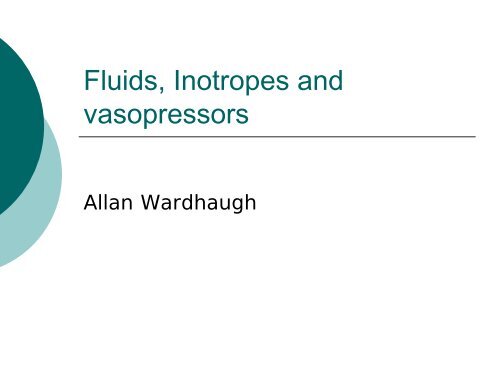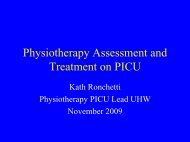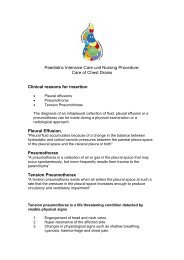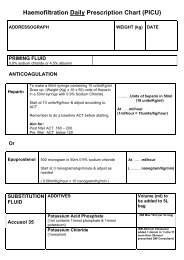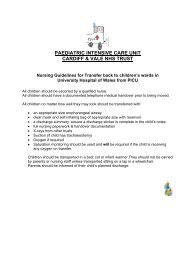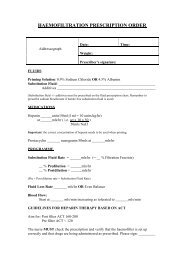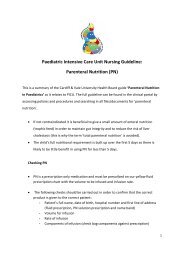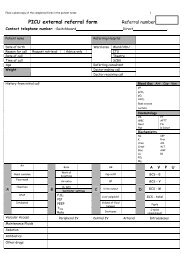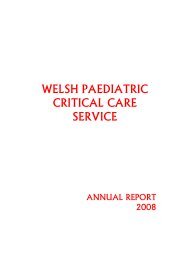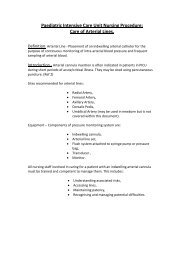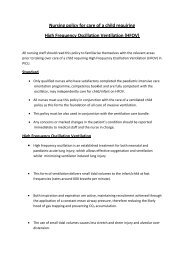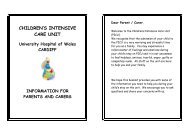Inotropes and vasopressores - Cardiff PICU
Inotropes and vasopressores - Cardiff PICU
Inotropes and vasopressores - Cardiff PICU
- No tags were found...
You also want an ePaper? Increase the reach of your titles
YUMPU automatically turns print PDFs into web optimized ePapers that Google loves.
Definition of ShockInadequate oxygen delivery totissues to meet dem<strong>and</strong> becauseof circulatory failure
PhysiologyO 2 delivery = (1.34 × Hb × O 2 sats) + (PO 2 × 0.023) × COAdults = 600ml/min/m 2Neonate = 665 – 1000ml/min/m 2
Physiology◦ Adult Oxygen dem<strong>and</strong> 120 – 220ml/min/m 2◦ Neonatal oxygen dem<strong>and</strong> 180 – 280ml/min/m 2◦ Neonates cardiac output near maximaleven at rest• Vulnerable to increase in dem<strong>and</strong>• Vulnerable to decrease in supply
Physiology – fluid filled circuit <strong>and</strong>Ohm’s Law◦ I = V/R◦ Flow = Pressure Difference/Resistance◦ Perfusion pressure = Cardiac output× Resistance
Compensation◦ Increase cardiac output• CO = SV × HR◦ HR dependent in infants◦ Relatively little capacity in neonates toincrease HR◦ Redistribute blood flow• Peripheral/ splanchnic vasoconstriction
Flow needs to be adequate forPerfusion pressureCritical point
Pathophysiology of Sepsis◦ Endothelial disease• Capillary leak◦ Hypovolaemia – hypovolaemic shock◦ ARDS – impaired oxygenation◦ Myocardial depression• IL-6 – cardiogenic shock◦ Abnormal vascular tone• High or low SVR – impaired organperfusion
Treatment goals◦ Improve oxygenation◦ Restore circulating volume◦ Improve cardiac contractility◦ Achieve effective organ perfusionpressures
A brief history of septic shock treatment
Outcome?U of M 1969 Medicine 48: 307-3297% Mortality G-ve sepsis
The search for a magic bulletFew R<strong>and</strong>omised studies◦ 3 Dengue Fever◦ 2 endotoxin antagonist (no effect)◦ APC no effect◦ Immunoglobulin 1989-91 (Saudi, Taiwan,Turkey India)◦ I small Polish Neonatal◦ 2 GM-CSF neonatal◦ HAS vs. saline Malaria
Efficacy variable Placebo N=235 ∗ DrotAA N=239 ∗ P ValueInfection site, % (n):LungBloodCNSIntra-abdominalOther21/86 (24.4)10/77 (13.0)2/17 (11.8)4/27 (14.8)4/28 (14.3)18/89 (20.2)7/74 (9.5)5/21 (23.8)6/17 (35.3)5/38 (13.2)0.36
esolve 28-day MortalityAdditional SubgroupsnDrotA(a)PlaceboAbsoluteRiskReductionresolve Overall47417.15%17.45%0.3DICNo DIC20318314.4%18.1%22.2%11.2%7.8-6.90.5 0.6 0.7 0.8 0.9 1 1.25 1.67 2Relative Risk of Death (Point Estimate <strong>and</strong> 95% CI)
Fluid resuscitation
Shock:GastroenteritisAbdo obstructionsepticaemia
Severe sepsis – Outcomes (9625 cases, US 1995)R Scott Watson AJRCCM 14 Nov 2002
Role of early fluid resuscitation in pediatricseptic shock.Carcillo JA, Davis AL, Zaritsky A. JAMA 1991 4;266(9):1242-5All children with septic shock to ER over 6 yearsPA catheter by 6 hours.Three groups based on fluid volume in the first hour:group 1, less than 20 mL/kg;group 2, 20 to 40 mL/kg; <strong>and</strong>group 3, more than 40 mL/kg.
RESULTS.34 patients (median age, 13.5 months)mL/kg (mean +/- SD)1 hour 6 hoursgroup 1 (n =14) 11 +/-6 71 +/-29group 2 (n=11) 32 +/-5 108 +/-54group 3 (n=9) 69 +/-19 117 +/-29
RESULTS.34 patients (median age, 13.5 months)DeathsmL/kg (mean +/- SD)1 hour 6 hoursgroup 1 (6/14) 57% 11 +/-6 71 +/-29group 2 (7/11) 63% 32 +/-5 108 +/-54group 3 (1/9) 11%* 69 +/-19 117 +/-29
CONCLUSIONRapid fluid resuscitation in excess of 40 mL/kg in the firsthour following emergency department presentationwas associated with:◦ improved survival◦ no increase in the risk of cardiogenicpulmonary edema or ARDS
7000 critically ill adults
Figure 3. Type of fluid administered before <strong>and</strong> after arrival of the <strong>PICU</strong> teama. Before arrival of <strong>PICU</strong> transfer teamb. After arrival of <strong>PICU</strong> transfer teamSalineGelofusinHASRBCFFPPltsOther
<strong>Inotropes</strong> <strong>and</strong> pressors
<strong>Inotropes</strong> <strong>and</strong> pressors◦ Advantages• Improve pumpfunction• Increase SVRimprovingperfusion pressure• Increase diastolicBP improvingcoronary arteryperfusion◦ Disadvantages• May increaseafterload• Increasemyocardial oxygendem<strong>and</strong>• Arrythmia• Extravasationdanger – should gocentrally
When to start inotropes◦ Sepsis – failure to respond to40ml/kg fluid in first hour◦ Will need adequate monitoring◦ Invasive BP if possible
Available inotropes <strong>and</strong> pressors◦ Natural catecholamines• Adrenaline• Noradrenaline• Dopamine◦ Synthetic catecholamines• Dobutamine◦ Phosphodiesterase inhibitors• Milrinone, enoximone◦ Pure pressors• Vasopressin, Terlipressin
Choice of inotrope◦ Personal preference◦ No RCT to rely on◦ Prejudices common – rememberthese are based on class 4evidence.◦ Watch the bottom line◦ ‘Warm’ shock with good CO <strong>and</strong> lowSVR less common in children◦ ‘Cold’ shock with low CO <strong>and</strong> highSVR more common – some usevasodilators
Catecholamine synthesis
Receptor2 ndmessengerActionsα 1IP 3, 1-2 DAG Vasoconstrictionα 2↓ cAMP Vasodilation, -vechronotropeβ 1↑ cAMP +ve inotrope &chronotropeβ 2↑cAMP Vasodilation,bronchodilationDA 1↑cAMP VasodilationDA 2↓cAMP Inhibits PLN & β-endorphin secretion
Dopamine◦ Precursor of noradrenaline.◦ α 1 , β 1 , β 2 , DA 1 , DA 2 receptors.◦ 5 – 15 mcg/kg/min β1 effectsdominate◦ > 15α1 becomeimportant◦ > 25α1 dominates◦ ‘Renal dose’ concept obsolete
Adrenaline◦ α 1 , β 1 , β 2 .◦ 0.05 – 0.3 µg/kg/min β 1, 2 > α 1 ,• β 2 effects may cause balanced effect on SVR.◦ 0.3 – 1 µg/kg/min β 1, 2 = α 1◦ > 1 µg/kg/min β 1, 2< α 1◦ Disadvantage - increase in myocardial O 2 dem<strong>and</strong><strong>and</strong> arrythmias
Noradrenaline◦ α1 <strong>and</strong> β1, with dominant α1effects.◦ β1
Dobutamine◦ Synthetic mixture of two stereo-isomers.◦ One isomer has β effects, the other α 1 .◦ 5 – 20 µg/kg/min β 1,2◦ Increases contractility◦ May ‘unmask’ hypovolaemia◦ SVR decreases. Direct coronaryvasodilatory effect.◦ >20 µg/kg/minα 1 dominates
Phosphodiesterase inhibitors◦ Enoximone <strong>and</strong> milrinone – bipyridine PDE3inhibitors.◦ PDE3 specific to myocardium.◦ Increases myocardial contractility, enhancesvascular smooth muscle relaxation - lusiotropic.◦ Decreases preload <strong>and</strong> afterload, reduce LVEDP<strong>and</strong> RVEDP improves diastolic dysfunction.◦ Heart rate <strong>and</strong> myocardial oxygen consumptionrelatively unchanged.◦ They are not generally first line agents, but areuseful in situations with β receptor downregulation.◦ Commonly used post cardio-pulmonary bypass.
Phosphodiesterase inhibitors◦ Enoximone – causes thrombocytopaenia.Available orally. Crystallises easily insolution.◦ Milrinone – shorter half-life, more proarrythmogenic.Accumulates in renalimpairment.◦ Commonly used in post-cardiac bypasscases◦ Ongoing MCRCT◦ May be useful in septic shock resistant toinotropes with increased SVR.
Vasopressin◦ Initially high endogenousvasopressin in septic shock <strong>and</strong>haemorrhagic shock◦ Secretion normally stimulated byhypovolaemia <strong>and</strong> hypotension◦ Prolonged hypotension or septicshock levels decrease
Vasopressin◦ Injection in humans with normal BP – no effectunless very high doses used◦ Injection of physiological doses in hypovolaemia –vasoconstrcition◦ Enhances sensitivity to catecholamines◦ Coronary, Pulmonary <strong>and</strong> cerebral vasodilator atphysiological doses.◦ Clinical studies – 0.01 – 0.04U/min improve BP<strong>and</strong> responsiveness to catecholamines in septic<strong>and</strong> vasodilatory shock◦ Higher doses cause pulmonary, coronary <strong>and</strong>renal vasoconstriction◦ RCT in adults shows improved CI, BP <strong>and</strong> fewerarrythmias if used with norad compared withnorad alone
Which inotropes when?
Goal targeted treatment
Benefit from individualised resuscitation to more detailed goalsdo the basics very well vs. doing basics wellSearch for cryptic shockVenous desaturation
Largest mortality benefit of any sepsis study
Shock should be clinically diagnosed,before hypotension occurs, by:hypothermia or hyperthermia,altered mental status,with peripheral vasodilationor cool extremities with capillary refill > 2 seconds
Does it work?
A Comparison of ACCM-PALS Guidelines to St<strong>and</strong>ard Care on Outcomefrom Pediatric Septic ShockA R<strong>and</strong>omized Control Trial (C Oliveira et al 2008)102 Septic ShockPatientsGoal normal perfusion Goal O 2 sat > 70%28 day Mortality20/51 (39.2%)28 day Mortality6/51(11.8%)OR 0.2 95% CI 0.07-0.57
Mortality associated with CV O 2sat < 70% was averted with intervention(C Oliveira et al)Mortality rate ifBaselineControl groupCV O 2 sat < 70%CV O 2 sat > 70%68.8 %21.7 %Intervention groupCV O 2 sat < 70% 13.3 %
◦ Case control study of fatal vs. nonfatalmeningococcal disease 1997-1999◦ 145 cases; 355 controls◦ Factors associated with death• Not under care of paediatrician• Failure of supervision by a consultant• Failure in administration of inotropes
Pitfalls
Common errors (1)◦ Failure to establishsecure access◦ Ventilation delayeduntil arrest
Common errors (1)◦ Failure to establishsecure access◦ -Intra-Osseousneedle after 90 secin shocked child◦ Ventilation delayeduntil arrest• Recognise severediseaselow WCCcoagulopathyextensive rash
Common errors (2)◦ Inadequate fluidadmin◦ Myocardialdepressant drugsadministered forinduction ofanaesthesia
Common errors (2)◦ Inadequate fluidadmin◦ 20mls/kg <strong>and</strong> rpt200mls/kg notunusual◦ Myocardialdepressant drugsadministered forinduction ofanaesthesiaFentanyl (+/- ketamine)Pancuronium/Suxnotthiopentonemidazolampropofol
Common errors (3)◦ KCl boluses◦ Large ET leak◦ Nasal intubation◦ dobutamine used alone
Common errors (3)◦ KCl boluses◦ Large ET leak◦ Total Body K + normal or high,anticipate acidosis◦ high pressure leak only◦ Nasal intubation◦ dobutamine used alone◦ Avoid in coagulopathy◦ AVOID dobutamineIf no CVL thenIO dopamine/adrenaline
Summary◦ Volume◦ <strong>Inotropes</strong>◦ Aggressive early treatment


